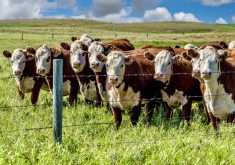I have been on slaughter and food-processing floors all over the world — vegetables, beef, pork, poultry, lamb, bison, elk, fruit, bake floors and many things in between.
Usually women work in these food plants, silent and relentlessly focused while working on raised catwalks as their male supervisors stand behind them. This is not only very intimidating and degrading but that structure, along with the noise, takes all the social aspect out of work.
It is all about line speed when we consider any type of processing, fabrication or manufacturing. The most costly thing to any manufacturer of any product, from cars to candy, is a slowing of the line because of incidents, product problems, malfunctions or an injury.
Read Also

More precious than gold
When commercial fertilizers no longer meet the needs of the world’s farmers, the value of manure will grow, says Alberta Farmer columnist Brenda Schoepp.
Many hands are required in food production, processing, warehousing, transport and in stocking shelves. In processing, to fill the floor and keep the line going, it is not unusual to bring in foreign workers; men and women who will work long hours. When the Trump administration recently “rounded up” workers and detained them, it left a gap on the floor and because the line does not slow, this puts further pressure on the employees left standing. Many studies have shown that injury is common. Silence is often expected.
The American food industry, and in particular the meat industry, has a long history of resisting government regulation and intervention. Currently, precedent-setting amendments may threaten food and food ingredient safety and the environment.
- More with Brenda Schoepp: Food culture runs deep and has many different facets
A recent example played out in July in the U.S. when Tyson Foods — which slaughters approximately 48,000 pigs, 30,000 head of cattle and six million chickens per day — lobbied and won the right to increase pollution in an “unnamed tributary.” In this amendment, chlorides in the Poteau River from that tributary can increase from 120 milligrams per litre to 185, sulphides can increase to 200 milligrams per litre up (over three times from the recommended 60), and dissolved solids jump from 500 milligrams per litre to 786. Levels of minerals were not specified but also had their ceilings increased.
This is no surprise as President Trump has managed to roll back, or is in the process of rolling back, 83 environmental rules. As of this fall, one amendment affecting the Food Safety and Inspection Service states that uninspected products such as pet food can be made in the same space as human food and is then not subject to inspection, as long as it is made “outside the hours of inspection.” Whether that product goes to a human or a pet in part depends on if it was processed during or outside of inspection hours. Meat is part of the $20 billion of food products and ingredients crossing from the U.S. to Canada.
What happens when food ingredients are produced in these spaces? What are the human rights and social impacts?
An internal U.S. government report clearly indicates a strong desire by the U.S. to increase ingredient sales to Canada in many areas, including baked goods, baby foods (including meats), processed fruits and vegetables, dairy, snacks, condiments, biscuits, rice, pasta, noodles and edible oils.
The report recognized that Canada has a “sophisticated” food-processing industry and an aware public that expects to be able to locally identify food and expects transparent corporate social responsibility. My question is: How do American food ingredients that are in a constant state of deregulation fall into the ethical Canadian food-processing space?
Our food workforce brings us thousands of ingredients as well as such staples as sliced bacon, salad in a bag, boxed kiwis, marinated steak, meat and meatless proteins, frozen cake, concentrated orange juice in a can, whipping cream, crackers, chicken kabobs, condiments, candies, pickles, berry jam, fish sticks, flour, frozen peas, falafels, popcorn shrimp, burritos, biryanis and dumplings. The list is eternally long. And, behind everything we eat is a real live person — someone’s mom or dad, sister or brother, husband or wife.
In the self-regulated and self-deregulated world of food, particularly in the U.S., we must remember that it is these folks who are critical in the process to bring nutrition to our plates. So often we say grace thanking ‘the hands that grew and prepared this food,’ but seldom does society acknowledge that someone had a mentally fatiguing job and stood on a line for 12 hours to bring it to the shelf.
As major trading partners and because of proximity, Canadian manufacturers might be careful that they are not guilty by association despite their own stringent food safety and food-processing protocols. Our consumers and our customers care.
In our efforts to provide the best quality in food and food products for ourselves and all Canadian export partners, we need to be cognizant of where that food or food ingredient was manufactured and what the environmental and social impact of that process was.
There is always a societal cost. The question of source and food safety principles, human rights and environment reach further than the ethical space. This is about economics and long-term survivability in a global marketplace that includes other sophisticated trading partners.
















